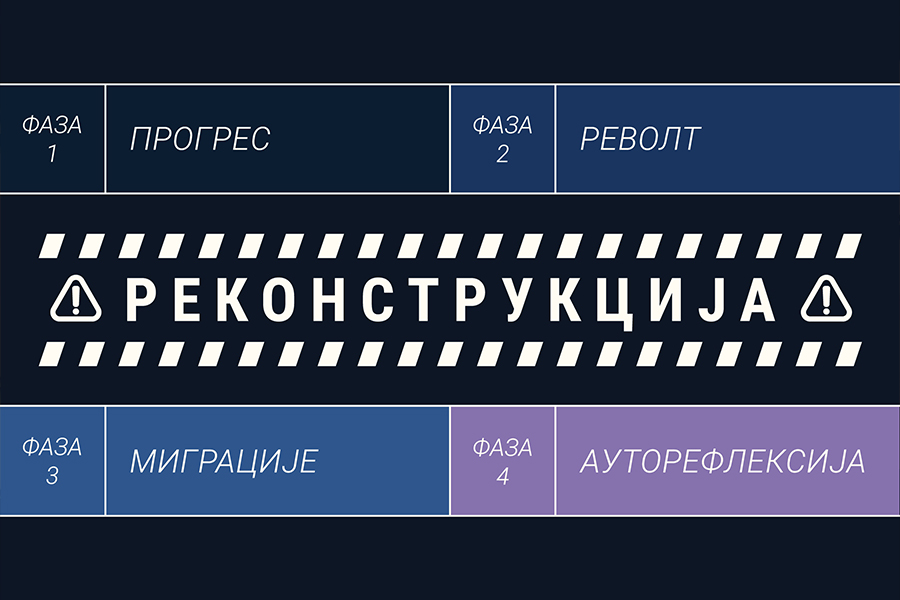The Museum of Contemporary Art of the Republic of Srpska presents its latest exhibition titled ‘Reconstruction’, a joint effort of four curators, conceptualised with the aim of conveying differing views about contemporary art in the Republic of Srpska and highlighting its heterogeneity.
Insight into and analysis of contemporary art in the Republic of Srpska reveals a profusion of art phenomena and artists, along with the extraordinary diversity of their interests, which are difficult to include in a single art show. With the entire country in lockdown due to COVID-19, the four curators of the Museum of Contemporary Art of the Republic of Srpska undertook an analysis of the local art scene and its activities in the period preceding the crisis, which the pandemic brought to the fore. Hence, a methodological approach was employed that included curatorial selection and problematisation of specific themes organised into discrete segments, then interconnected and made to function as a coherent semantic unit. The four themes singled out appear common and recurrent in both the local and global contexts, an approach that affords insight into how the local scene has developed relative to trends in art around the world. Those themes are revolt, migrations, self-reflection and progress, as realised by the selected artists through the use of different arts, materials, techniques and strategies.
‘Reconstruction’ puts forward four possible perspectives, that is, expressed symbolically, four phases that problematise and contextualise the contemporary art practices emergent and/or found in this part of the world, and that also open up possibilities for new explorations and conclusions. Тhe title of the exhibition directly refers to the reconstruction that the institution is undergoing, that way connecting the will for progress and change, and symbolically taken to refer to a new methodological model that explores specific themes and phenomena in contemporary art, as well as means of connecting them to new museology concepts. The authors of exhibition concept was proposed by senior curators Lana Pavlović and Žana Vukičević, and curators Maša Čavić and Mladen Banjac.
The exhibition includes works by 22 artists who appeared and formed – or are currently working – on the contemporary scene in the Republic of Srpska: Nada Arnaut, Aleksandar Bajunović, Viktorija Banda, Igor Bošnjak, Mladen Bundalo, Dragana Vidljinović, Dragana Grašar, Milena Ivić, Nikola Кekerović, Ninoslav Кovačević, Nina Кomel, Aleksandra Кuzmanović, Vesna Majstorović, Nenad Malešević, Miodrag Manojlović, Radenko Milak, Mladen Miljanović, Aleksandar Milošević, Renato Rakić, Vojislav Ritan, Diana Todić, and Glorija Tubak.
There is a special focus on young artists, who will have a chance, for the first time ever, to take a big step forward and show their artwork at a collaborative museum exhibition, side by side with works of established artists with successful international careers.
The project has been designed as a four-piece mosaic and hopes to capture public attention by staging these individual pieces in galleries, museums and cultural centres around the Republic of Srpska, as well as in major museums across the region. While concentrating its efforts on the promotion of culture decentralisation, it may be shown as a stand-alone exhibition, and may also include one or more individual segments or all of it.
Curatorial concepts:
PHASE 1/ PROGRESS
‘This segment is a review of the work of local artists belonging to the youngest generation, the so-called Generation Z (Aleksandra Кuzmanović, Aleksandar Bajunović, Aleksandar Milošević, Dragana Grašar and Glorija Tubak). It explores the relation these youngest artists have toward current social and global trends and phenomena, expressed in the classical form of painting as the most easily recongisable art medium. Our goal is not only to present young artists’ views, but also to compare their work to the works of art and phenomena that emerged in conditions similar to these we now have on the scene these young people work on. Communication between young artists and those belonging to older generations is a secondary aspect, but it is just as interesting and methodologically highly relevant for explorations of local art, because it can provide indications as to how it might develop in the future.’
Mladen Banjac
PHASE 2/REVOLT
‘The thematic segment to run under the title “Revolt” will present works by artists Milena Ivić, Diana Todić, Dragana Vidljinović, Nikola Кekerović, Ninoslav Кovačević and Renato Rakić, whose stance is activist and who try to lay bare elements of social pathology. Here, the aim is to show the ways in which young artists use their talent and creativity to influence public opinion. The selected works deal with a range of themes related to social activism, such as the place of an individual in society and how society treats its individual members, treatment of intellectual property and cultural heritage, and criticism of local mentality.’
Maša Čavić
PHASE 3/MIGRATIONS
‘The works I have selected for the segment titled “Migrations” were made by artists Radenko Milak, Mladen Miljanović, Igor Bošnjak, Nina Кomel and Mladen Bundalo, who deal with different kinds of experience of displacement, dislocation and non-belonging. Irrespective of what it is they deal with – the migrations that followed the 1990s wars, the European refugee crisis or the social phenomenon of economic migrations that Bosnia and Herzegovina is confronted with – these artists share the need to respond to the instability, unpredictability and volatility of today’s world.’
Žana Vukičević
PHASE 4/SELF-REFLECTION
‘Beside the wide variety of themes found in local art, we thought it should be important to present artists who deal with self-reflection and whose positions manifest their different artistic sensitivities (Nada Arnaut, Viktorija Banda, Vojislav Ritan, Miodrag Manojlović, Nenad Malešević and Vesna Majstorović). These artists explore the nature of their true selves using a range of methods, such as the self-portrait – photographs posted on social networks, capturing unexpected shots and scenes, delving into memories and the unconscious, forging links between the artist and viewer, as well as the artist and nature.’
Lana Pavlović

